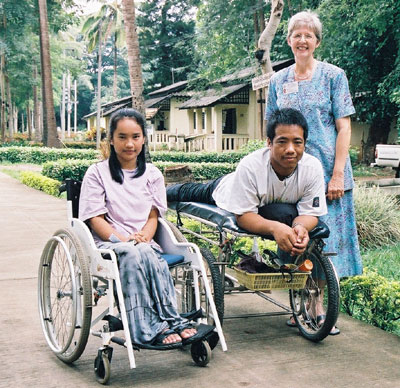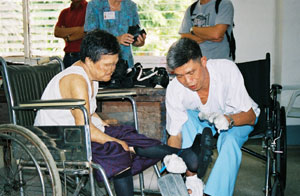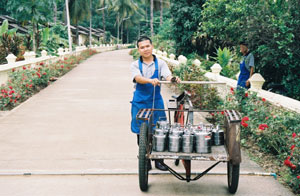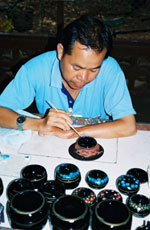
DAVID ADAMS reports on the life-reclaiming work of the McKean Rehabilitation Institute in Chiang Mai, Thailand…
Chiang Mai, Thailand, wasn’t the first place that sprang to mind when Melbourne couple Heather Smith and her husband, Dr Trevor Smith, thought about travelling overseas as missionaries.
It wasn’t even on the list. But 35 years after first setting foot in the South East Asian country, they’re still there helping people with leprosy and disabilities to live a productive and fulfilling life.

Heather Smith with two people who were staying at the McKean Rehabilitation Institute when Sight visited last year. PICTURES: David Adams
“We no longer need to bring people out of the community because they’ve got leprosy. But to change the whole community mindset is a difficult thing so we’ve had to be involved in public education and health education; in problem-solving, in counselling within individual families and individual villages. And gradually, gradually, gradually over the next 15 years we were able to re-locate back into the community people who had expected to have to bein a leprosy centre for life.”
– Heather Smith
“After we become Christians ourselves, we both felt individually God was calling us, leading us into mission work,” explains Heather Smith in Chiang Mai recently.
“I guess I was looking towards Indonesia because I was teaching Indonesian in highschool in Australia and we thought maybe God was going to use the language I had already. But we felt there really weren’t the openings for GPs which is what Trevor was.”
The couple – Trevor, then 28, had spent his junior and senior residency years at Geelong Hospital and Heather, then 24, was working as a teacher – met with a representative of the world-wide Leprosy Mission who during their discussions about Indonesia, informed them of the need for skilled medical professionals in the northern parts of Thailand and of the work being done in Chiang Mai at a place now known as the McKean Rehabilitation Institute.
“We really weren’t tuned in…” says Heather, now 59. “(But) then we went off to do a locum in Warracknabeal and it was while we were up there that Trevor and I both – completely independently – felt that this was the place we were meant to be.
“I was feeding my baby and reading the New Testament…and the words just stood out in dark black letters and it was ‘use the present opportunity to the full’. And I just knew it applied to this place that this man had talked about. I couldn’t remember where it was or what it’s name was in Thailand. I was just certain that’s what the scripture was applying to.
“So that night when Trevor came home, I said ‘Have you ever thought anymore about that place in Thailand that (the man from the mission) talked about?’ And Trevor said, ‘Well, yeah. I feel I’m meant to be there.’”

People living at the institute are encouraged to develop skills, such as making prosthetics, to help others with disabilities (above). Meals on wheels deliveries to residents (below). Residents are encouraged to develop skills to help them develope sustainable livelihoods when they return to the community (far below).


With a seven month old baby – Graeme, the first of their two sons and two daughters – and not really having much idea about what to expect, in May 1969, they packed their bags and left Australia as part of a team of medical professionals under the banner of the Leprosy Mission – an international organisation founded in the late 1800s to help care for people suffering from leprosy.
Little did the Smiths know then that their destination would be their home for the next 35 years.
The first place to receive people suffering from leprosy in South East Asia, the McKean Rehabilitation Institute was founded in 1908 by a Presbyterian medical missionary, Dr James McKean, after he saw first-hand the plight of leprosy sufferers while working in a clinic in Chiang Mai.
The Crown Prince of Chiang Mai gave him use of 160 acres of land not far from the centre of Chiangmai which nobody wanted. Surrounded by the river on one side and a canal on the other, the story went that a white elephant once owned by a prince had gone wild and had as a result been confined to living on the land until it had died. No-one then wanted the ‘island’ for fear of the spirit of the “wild, white elephant”.
Initially no more than a series of bamboo shacks, the institute has since added hostels, a hospital and residential cottages as well as occupational and physical therapy, prosthetics and orthotics departments and a wheelchair factory.
Doctors at the institute – including Dr Smith, who at 63 is the medical superintendent and works as a surgeon and clinician – employ reconstructive surgical techniques developed at the institute and at other leprosy hospitals around the world by experts including Paul Brand which enable tendons from one part of the body to be used to correct leprosy-related disabilities which may include the clawing of hands and an inability to blink or to lift up feet.
The doctors also hold regular clinics in the surrounding areas for people suffering leprosy (also known as Hansen’s Disease) and other skin complaints, seeing anywhere between 50 and 100 patients a day.
The first effective cure for leprosy – a drug called dapsone – was introduced in the Forties, and used at the institute – which has been run by the national protestant church, the Church of Christ in Thailand, since 1934. Many patients were healed but some became dapsone-resistant.
Multi-drug therapy was introduced in the early 1980’s, and is proving effective. McKean widened it’s focus to the rehabilitation of leprosy sufferers and their reintegration back into the community. Some who were unable to return home were resettled in specially created communities and supported in agricultural work.
A decrease in the incidence of leprosy – there are now only around 1,000 cases a year in Thailand with many of these coming from other countries – has also brought about changes in the institute’s focus. Recent years have seen it broadening to provide care for people who have a broad range of disabilities alongside those disabled because of leprosy.
While there is still a village located on-site for 100 elderly disabled patients who have no home to return to or couldn’t survive on their own, these days the majority of patients who come to receive treatment at McKean eventually return to their own homes where they may receive ongoing community-based rehabilitation and support to overcome socio-economic difficulties or stigma.
“From the Seventies on, we’ve been looking to rehabilitate people back into the community,” says Heather Smith, who is the assistant director at the institute and head of the vocational team, and like her husband, an associate missionary with Global interAction (formerly known as the Australian Baptist Missionary Service).
“We no longer need to bring people out of the community because they’ve got leprosy. But to change the whole community mindset is a difficult thing so we’ve had to be involved in public education and health education; in problem-solving, in counselling within individual families and individual villages. And gradually, gradually, gradually over the next 15 years we were able to re-locate back into the community people who had expected to have to be in a leprosy center for life.”
One of the most important roles of the institute is helping people to establish sustainable livelihoods. This may include vocational training, ranging from improved farming techniques through to learning cooking or craft skills.
“It’s encouraging people to start thinking again about being involved in productive activities and being self-supporting, rather than thinking, ‘I’m a burden’,” says Smith.
The Smiths, who were awarded the Carey Baptist Grammar School’s Carey Medal in 2003 for their work, have had to make some hard choices in their time at McKean.
There are things they miss about Australia – family and friends, for one – and while they are officially supposed to return to Australia every two years for a months – when Burwood becomes home – it doesn’t always work out that way.
They’ve also had to watch as each of their children returned to Australia to complete their schooling once they’d reached high school.
“Each time that happened it was a stress but each time God provided an opportunity for home and schooling for them and…and each time our kids felt that we were meant to stay,” says Smith.
Asked when or if she and her husband might return to Australia, Smith looks out at the cottages we’re driving past.
“There’s still a work to be done.”





